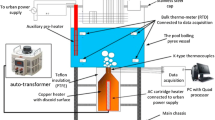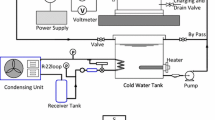Abstract
A set of experiments were conducted in a high-fidelity test rig to develop a new understanding on the role of magnetic field on the particulate fouling of iron oxide/ethylene glycol nano-suspension under a high heat flux pool boiling regime. Nano-suspensions were prepared at mass concentrations 0.1 and 0.2% and the tests were conducted up to heat flux 900 kW/m2. Influence of different operating parameters including heat flux, mass concentration of nanoparticles, the strength of magnetic field and bulk temperature on the pool boiling heat transfer coefficient (as an index for thermal performance) and particulate fouling resistance of the surface was experimentally investigated and discussed. Results showed that the presence of magnetic field lowers the fouling resistance and increases the heat transfer coefficient at any mass concentrations of test nanofluid. Likewise, an increase in the bulk temperature of nanofluid increased the heat transfer coefficient as well. For any mass concentrations, presence of the magnetic field suppressed the fouling rate. For all the experiments, the fouling thermal resistance reached the asymptotic point in which the fouling resistance remains constant. The value of the asymptotic point was increased with an increase in the mass concentration of nanofluid. Eventually, magnetic field was found to mitigate the fouling formation of nanoparticles at any heat fluxes, mass concentration and bulk temperature of nanofluids.











Similar content being viewed by others
Abbreviations
- h :
-
heat transfer coefficient, W/m2. K
- I :
-
Current, Ampere
- k :
-
Thermal conductivity, W/m. K
- q :
-
Heat flux, kW/m2
- R f :
-
Fouling resistance, m2. °C/kW
- T :
-
Temperature, °C or K
- V :
-
Voltage, volt
- Z :
-
axial distance between thermocouples, m
- b :
-
bulk
- c :
-
Clean
- f :
-
Fouling
- W :
-
wall
- α :
-
Heat transfer coefficient, W/m2. K
- ∆:
-
Difference
References
Sarafraz M, Arya A, Hormozi F, Nikkhah V (2017) On the convective thermal performance of a CPU cooler working with liquid gallium and CuO/water nanofluid: a comparative study. Appl Therm Eng 112:1373–1381
Sarafraz M, Hormozi F (2014) Scale formation and subcooled flow boiling heat transfer of CuO–water nanofluid inside the vertical annulus. Exp Thermal Fluid Sci 52:205–214
Sarafraz M, Hormozi F (2014) Convective boiling and particulate fouling of stabilized CuO-ethylene glycol nanofluids inside the annular heat exchanger. Int Commun Heat Mass Transfer 53:116–123
Sarafraz M, Hormozi F (2014) Nucleate pool boiling heat transfer characteristics of dilute Al 2 O 3–ethyleneglycol nanofluids. Int Commun Heat Mass Transfer 58:96–104
Sarafraz M, Peyghambarzadeh S, Alavifazel S (2012) Enhancement of nucleate pool boiling heat transfer to dilute binary mixtures using endothermic chemical reactions around the smoothed horizontal cylinder. Heat Mass Transf 48:1755–1765
Sarafraz M, Kiani T, Hormozi F (2016) Critical heat flux and pool boiling heat transfer analysis of synthesized zirconia aqueous nano-fluids. Int Commun Heat Mass Transfer 70:75–83
Peng H, Ding G, Jiang W, Hu H, Gao Y (2009) Heat transfer characteristics of refrigerant-based nanofluid flow boiling inside a horizontal smooth tube. Int J Refrig 32:1259–1270
Kim SJ, McKrell T, Buongiorno J, Hu L-w (2010) Subcooled flow boiling heat transfer of dilute alumina, zinc oxide, and diamond nanofluids at atmospheric pressure. Nucl Eng Des 240:1186–1194
Witharana S (2003) Boiling of refrigerants on enhanced surfaces and boiling of nanofluids. Royal Institute of Technology, Stockholm, Stockholm
Ding Y, Chen H, Wang L, Yang C-Y, He Y, Yang W, Lee WP, Zhang L, Huo R (2007) Heat transfer intensification using nanofluids. KONA Powder Part J 25:23–38
Liu Z-H, Yang X-F, Xiong J-G (2010) Boiling characteristics of carbon nanotube suspensions under sub-atmospheric pressures. Int J Therm Sci 49:1156–1164
Peyghambarzadeh S, Sarafraz M, Vaeli N, Ameri E, Vatani A, Jamialahmadi M (2013) Forced convective and subcooled flow boiling heat transfer to pure water and n-heptane in an annular heat exchanger. Ann Nucl Energy 53:401–410
Sarafraz M, Hormozi F (2014) Experimental study on the thermal performance and efficiency of a copper made thermosyphon heat pipe charged with alumina–glycol based nanofluids. Powder Technol 266:378–387
Sarafraz M, Peyghambarzadeh S (2013) Experimental study on subcooled flow boiling heat transfer to water–diethylene glycol mixtures as a coolant inside a vertical annulus. Exp Thermal Fluid Sci 50:154–162
Sarafraz M, Hormozi F, Peyghambarzadeh S (2015) Role of nanofluid fouling on thermal performance of a thermosyphon: are nanofluids reliable working fluid? Appl Therm Eng 82:212–224
Nikkhah V, Sarafraz M, Hormozi F, Peyghambarzadeh S (2015) Particulate fouling of CuO–water nanofluid at isothermal diffusive condition inside the conventional heat exchanger-experimental and modeling. Exp Thermal Fluid Sci 60:83–95
He Y, Jin Y, Chen H, Ding Y, Cang D, Lu H (2007) Heat transfer and flow behaviour of aqueous suspensions of TiO 2 nanoparticles (nanofluids) flowing upward through a vertical pipe. Int J Heat Mass Transf 50:2272–2281
You S, Kim J, Kim K (2003) Effect of nanoparticles on critical heat flux of water in pool boiling heat transfer. Appl Phys Lett 83:3374–3376
Xing M, Yu J, Wang R (2016) Effects of surface modification on the pool boiling heat transfer of MWNTs/water nanofluids. Int J Heat Mass Transf 103:914–919
Hu Y, Li H, He Y, Wang L (2016) Role of nanoparticles on boiling heat transfer performance of ethylene glycol aqueous solution based graphene nanosheets nanofluid. Int J Heat Mass Transf 96:565–572
Naphon P (2015) Effect of magnetic fields on the boiling heat transfer characteristics of Nanofluids. Int J Thermophys 36:2810–2819
Verplaetsen F, Berghmans JA (1998) The influence of an electric field on the heat transfer rate during film boiling of stagnant fluids. Rev Gén Therm 37:83–88
Arias F (2010) Film boiling in magnetic field in liquid metals with particular reference to fusion reactor project. J Fusion Energ 29:130–133
Pourmehran O, Rahimi-Gorji M, Ganji DD (2017) Analysis of nanofluid flow in a porous media rotating system between two permeable sheets considering Thermophoretic and Brownian motion. Therm Sci 21(5):2057–2067
Tabassum R, Mehmood R, Pourmehran O, Akbar NS, Gorji-Bandpy M (2017) Impact of viscosity variation on oblique flow of Cu–H2O nanofluid. Proc Inst Mech Eng, Part E: J Process Mech Eng 20. https://doi.org/10.1177/0954408917732759
Yousefi M, Pourmehran O, Gorji-Bandpy M, Inthavong K, Yeo L, Tu J (2017) CFD simulation of aerosol delivery to a human lung via surface acoustic wave nebulization. Biomech Model Mechanobiol 16:2035–2050
Fan L-W, Li J-Q, Li D-Y, Zhang L, Yu Z-T, Cen K-F (2015) The effect of concentration on transient pool boiling heat transfer of graphene-based aqueous nanofluids. Int J Therm Sci 91:83–95
Ali HM, Generous MM, Ahmad F, Irfan M (2016) Experimental investigation of nucleate pool boiling heat transfer enhancement of TIO 2-water based nanofluids. Appl Therm Eng
Aminfar H, Mohammadpourfard M, Maroofiazar R (2014) Experimental study on the effect of magnetic field on critical heat flux of ferrofluid flow boiling in a vertical annulus. Exp Thermal Fluid Sci 58:156–169
Lee T, Lee JH, Jeong YH (2013) Flow boiling critical heat flux characteristics of magnetic nanofluid at atmospheric pressure and low mass flux conditions. Int J Heat Mass Transf 56:101–106
Abdollahi A, Salimpour MR, Etesami N (2017) Experimental analysis of magnetic field effect on the pool boiling heat transfer of a ferrofluid. Appl Therm Eng 111:1101–1110
Yang P, Tarng YS (1998) Design optimization of cutting parameters for turning operations based on the Taguchi method. J Mater Process Technol 84:122–129
Sarafraz M, Nikkhah V, Nakhjavani M, Arya A (2017) Fouling formation and thermal performance of aqueous carbon nanotube nanofluid in a heat sink with rectangular parallel microchannel. Appl Therm Eng 123:29–39
Sarafraz M, Hormozi F, Peyghambarzadeh S (2014) Thermal performance and efficiency of a thermosyphon heat pipe working with a biologically ecofriendly nanofluid. Int Commun Heat Mass Transfer 57:297–303
Kamalgharibi M, Hormozi F, Zamzamian SAH, Sarafraz M (2016) Experimental studies on the stability of CuO nanoparticles dispersed in different base fluids: influence of stirring, sonication and surface active agents. Heat Mass Transf 52:55–62
Salari E, Peyghambarzadeh SM, Sarafraz MM, Hormozi F (2016) Boiling thermal performance of TiO2 aqueous nanofluids as a coolant on a disc copper block. Period Polytech Chem Eng 60:106
Moffat RJ (1988) Describing the uncertainties in experimental results. Exp Thermal Fluid Sci 1:3–17
Sarafraz MM (2012) Nucleate pool boiling of aqueous solution of citric acid on a smoothed horizontal cylinder. Heat Mass Transf 48:611–619
Peyghambarzadeh S, Vatani A, Jamialahmadi M (2013) Influences of bubble formation on different types of heat exchanger fouling. Appl Therm Eng 50:848–856
Shahmoradi Z, Etesami N, Esfahany MN (2013) Pool boiling characteristics of nanofluid on flat plate based on heater surface analysis. Int Commun Heat Mass Transfer 47:113–120
Ciloglu D, Bolukbasi A (2015) A comprehensive review on pool boiling of nanofluids. Appl Therm Eng 84:45–63
Abdollahi A, Salimpour MR, Etesami N (2016) Experimental analysis of pool boiling heat transfer of ferrofluid on surfaces deposited with nanofluid. Modarres Mech Eng 16(2):19–30
Acknowledgements
Authors of this work appreciate the University of Adelaide and Centre for energy technology Denmark for the scientific support. The first author of this work tends to appreciate school of Mechanical Engineering, the University of Adelaide for their scientific support. Prof Maziar Arjomandi and M. M. Sarafraz are highly appreciated for their great scientific supports.
Author information
Authors and Affiliations
Corresponding author
Ethics declarations
Conflict of interest
The authors declare that there is no conflict of interest for the paper.
Additional information
Publisher’s Note
Springer Nature remains neutral with regard to jurisdictional claims in published maps and institutional affiliations.
Rights and permissions
About this article
Cite this article
Arya, H., Sarafraz, M.M. & Arjomandi, M. Pool boiling under the magnetic environment: experimental study on the role of magnetism in particulate fouling and bubbling of iron oxide/ethylene glycol nano-suspension. Heat Mass Transfer 55, 119–132 (2019). https://doi.org/10.1007/s00231-018-2438-8
Received:
Accepted:
Published:
Issue Date:
DOI: https://doi.org/10.1007/s00231-018-2438-8




